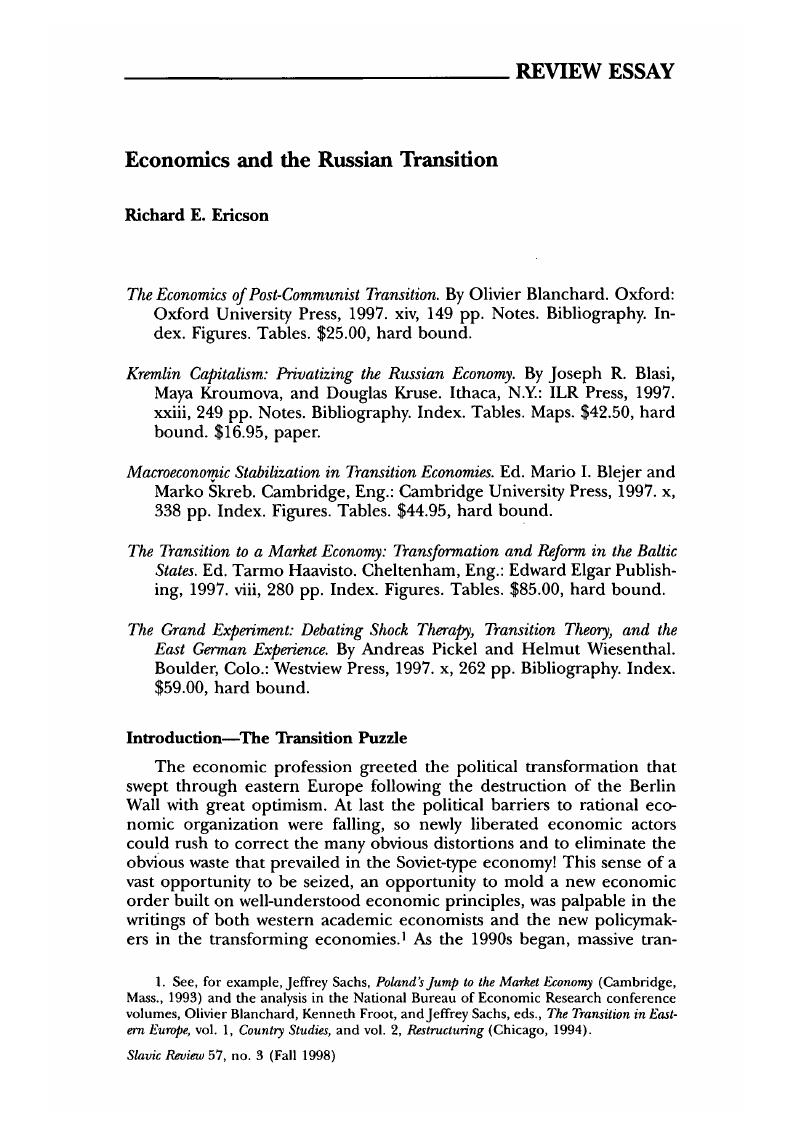Article contents
Economics and the Russian Transition
Published online by Cambridge University Press: 27 January 2017
Abstract

- Type
- Review Essay
- Information
- Copyright
- Copyright © Association for Slavic, East European, and Eurasian Studies. 1998
References
1. See, for example, Sachs, Jeffrey, Poland's Jump to the Market Economy (Cambridge, Mass., 1993)Google Scholar and the analysis in the National Bureau of Economic Research conference volumes, Olivier Blanchard, Kennedi Froot, and Jeffrey Sachs, eds., The Transition in Eastern Europe, vol. 1, Country Studies, and vol. 2, Restructuring (Chicago, 1994).
2. Again, Blanchard, Froot, and Sachs, eds., Transition in Eastern Europe, gives clear voice to that surprise, as well as attempting to explain why it should have occurred. Others with a better understanding of the structure and functioning of Soviet–type economies were less surprised by these negative outcomes, having cautioned that transforming the system must cause serious disruption. See, for example, Peter Murrell, “The Transition According to Cambridge, Mass.,” Journal of Economic Literature 33, no. 1 (March 1995), and Winiecki, Jan, “The Inevitability of a Fall in Output in the Early Stages of Transition to the Market,” Soviet Studies 43, no. 4 (1991): 669–76.CrossRefGoogle Scholar
3. A nice reflection of the debate at this stage can be found in Christopher Clague and Gordon Rausser, eds., The Emergence of Market Economies in Eastern Europe (Cambridge, Mass., 1992). The gradualist approach was also supposed to be represented by the apparently successful marketization of the Chinese economy since 1978, although questions of its comparability and feasibility in the eastern European context were never clearly addressed or resolved at the time. In more recent studies, differences in initial conditions are generally taken as decisive for the differences in approach and success. See, for example, the summary discussion in the World Bank report, From Plan to Market: World Development Report 1996 (Oxford, 1997).
4. I do not attempt to review all of the chapters or arguments, particularly in the conference volumes; instead, I draw on diose arguments and resulting conclusions to paint a picture of what economic analysis has to say about the most complex and interesting of the transitions, that of Russia.
5. See especially Mardia deMelo, Cevdjet Denizer, and Alan Gelb, “From Plan to Market: Patterns of Transition,” in Blejer and škreb, eds., Macmeconomic Stabilization in Transition Economies.The standard economic understanding of what has happened is more fully outlined in the World Bank report, From Plan to Market, and in the survey article by Anders Åslund, Peter Boone, and Johnson, Simon, “How to Stabilize: Lessons from Post–Communist Countries,” Brookings Papers on Economic Activity, no. 1 (1997).Google Scholar
6. Indeed, in Hungary the opposition (Socialist) victory actually led to a more radical implementation of the reforms. See Janos Kornai, “The Political Economy of the Hungarian Stabilization and Austerity Program,” in Blejer and Skreb, eds., Macroeconomic Stabilization in Transition Economies, chap. 6.
7. These are key nonmonetary (i.e., “real “) macroeconomic variables that began at an apparendy high level, dropped low, and then recovered to differing degrees, creating a U–shaped graph.
8. Mundell, “The Great Contraction in Transition Economies,” in Blejer and škreb, eds., Macroeconomic Stabilization in Transition Economies, chap. 2.
9. A fourdi such process, which Blanchard calls “reorganization,” is analyzed in an unpublished work by Gerard Roland and Thierry Verdier to which he refers without further discussion.
10. Such factors as the failure and closure of state and/or privatized firms fliat do not restructure in time thereby reducing social product and increasing unemployment, low levels of public investment as resources are absorbed in supporting the unemployed, and barriers to bringing in new management through privatization all undercut the restructuring of state, and the entry of new, enterprises.
11. For an outline of the components of the Russian program, as well as an intelligent survey of the state of transition across eastern Europe as of 1994, see Lavigne, Marie, The Economics of Transition (New York, 1995).CrossRefGoogle Scholar
12. The facts can be found in numerous places, including at the end of the relevant chapters in Blanchard, The Economics of Post–Communist Transition and the World Bank report, From Plan to Market. They are also the subject of constant commentary in the Russian press.
11. For an outline of the components of the Russian program, as well as an intelligent survey of the state of transition across eastern Europe as of 1994, see Lavigne, Marie, The Economics of Transition (New York, 1995).CrossRefGoogle Scholar
12. The facts can be found in numerous places, including at the end of the relevant chapters in Blanchard, The Economics of Post–Communist Transition and the World Bank report, From Plan to Market. They are also the subject of constant commentary in the Russian press.
13. For a good introduction to the twists and turns of policy in the first three years of the Russian transition, see Anders Aslund, How Russia Became a Market Economy (Washington, D.C., 1995). For a definitive account of the thinking behind privatization policies and of die design of that reform, see Maksim Boicko, Andrei Shleifer, and Robert Vishny, Privatizing Russia (Cambridge, Mass., 1995).
14. A prime example is mayor Iurii Luzhkov's hijacking of privatization in Moscow, which tremendously enhanced his ability to dominate the city and extract rents from virtually all economic activities.
15. Fascinating, yet still unpublished, research on regional variations by Dan Berkowitz of the University of Pittsburgh has been presented at recent conventions of the American Association for the Advancement of Slavic Studies (November 1997) and Allied Social Science Associations (January 1998).
- 7
- Cited by




